Last Updated on July 10, 2017 by Andrew Culture
17 of Arturia’s finest synth, organ and piano instruments in one heavily discounted box!
Product: V Collection 5
Manufacturer: Arturia
Web: https://www.arturia.com/
Price: €499
It’s that time of year when Arturia wraps up its software instruments in a bundle and makes you an offer it hopes you can’t refuse.
This is going to take a while so grab your beverage of choice and get comfortable…
As you can tell from the name, V Collection 5 is the fifth such package and it contains a total of 17 soft instruments including five new to the V Collection.
Let’s list them. The first five are the new additions.
- Synclavier V.
An emulation of the Synclavier Digital Synthesiser combining FM (Frequency Modulation) and Timbre Frame synthesis. One of the first polyphonic digital sampling workstations and unfeasibly expensive.

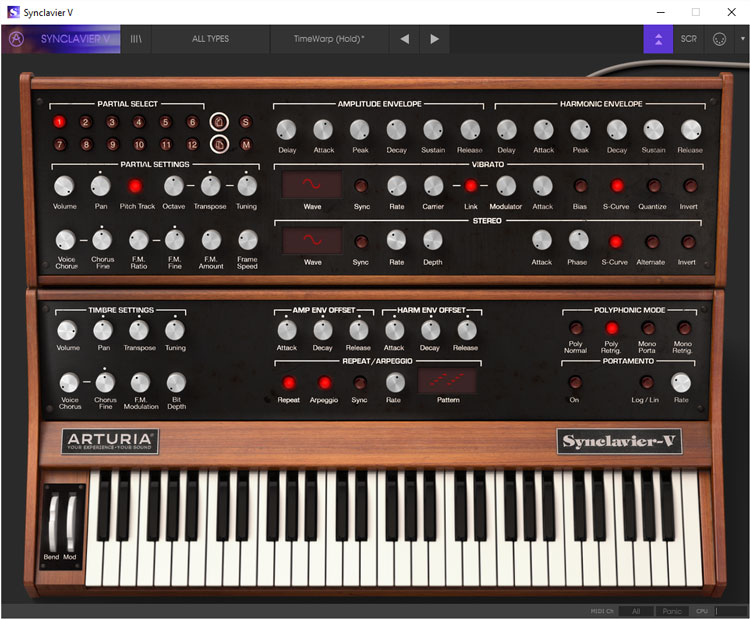
- B-3 V.
A recreation of the classic Hammond B3 tone wheel organ and Leslie speaker.


- Farfisa V.
A software version of the Farfisa Compact Deluxe Organ.

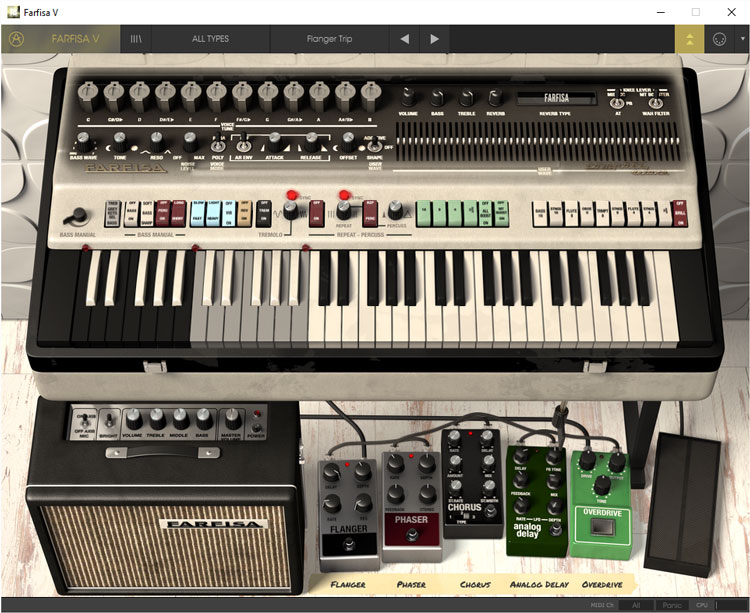
- Stage-73 V.
An emulation of the Fender Stage 73 Electric Piano.

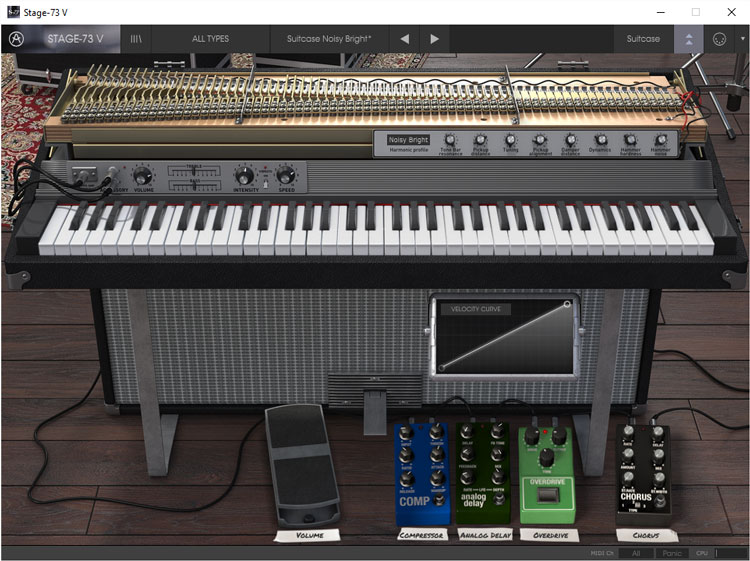
- Piano V.
An emulation of five piano types based on a range of upright and concert grand models.

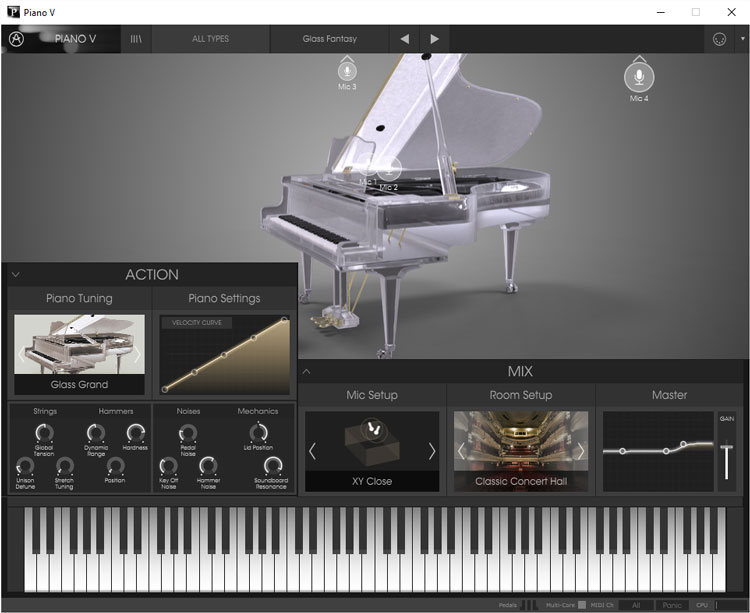
- Mini V.
A software version of the famous Minimoog synthesiser.


- ARP2600 V.
A software emulation of the ARP 2600 modular synthesiser.

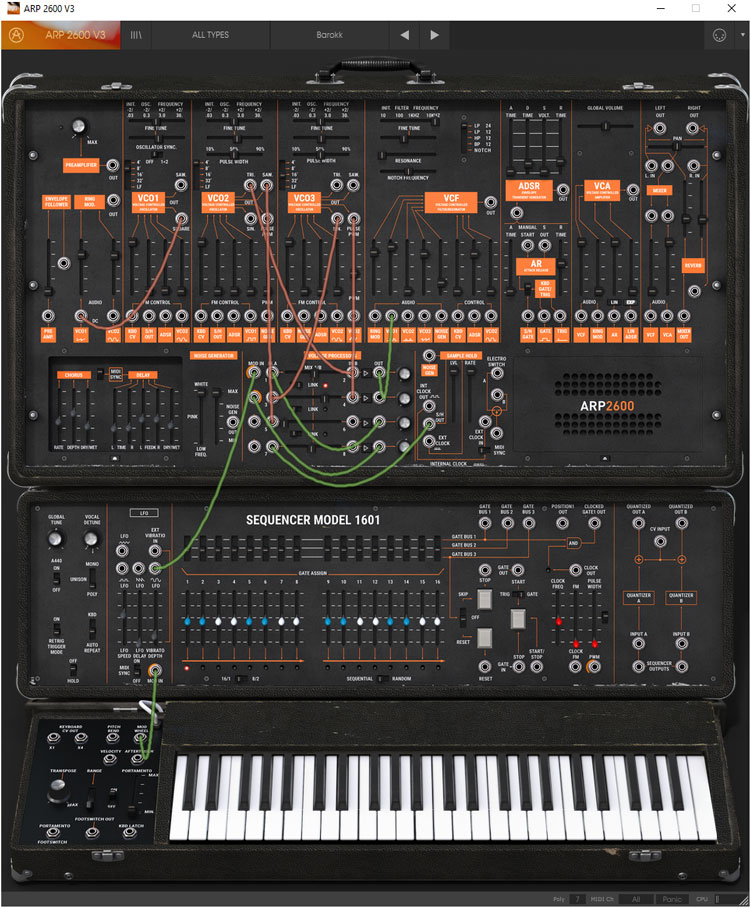
- CS-80 V.
An emulation of one of Japan’s defining synthesisers, Yamaha’s CS-80, released in 1976 at a cost of $6,900 – according to Mr Google that’s $29,405.81 in today’s money!

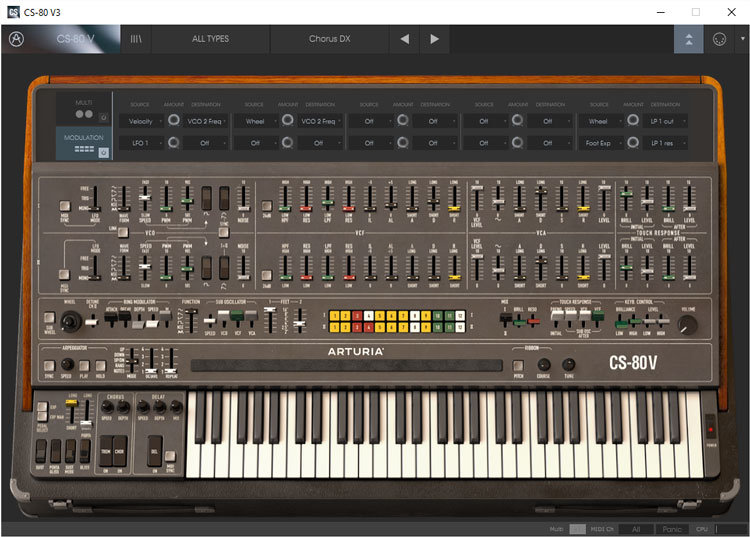
- Jup-8 V.
An emulation of Roland’s Jupiter 8. In 1982 it was upgraded to the JP8A with several enhancements.

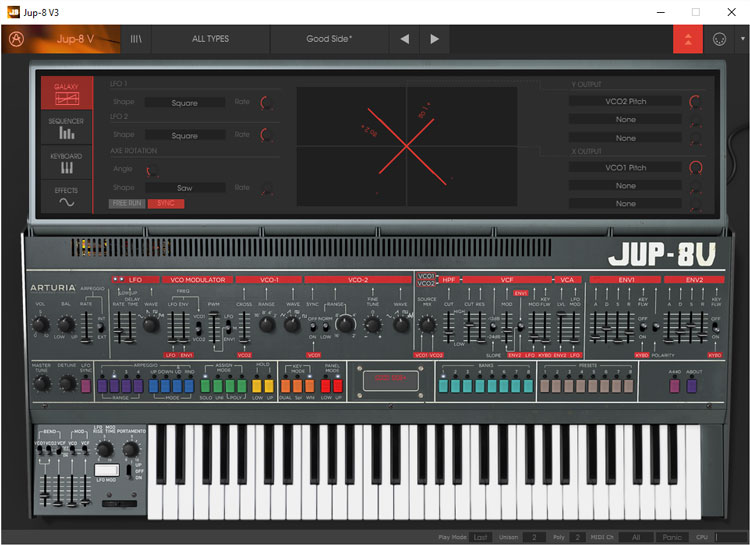
- Matrix 12 V.
An emulation of Oberheim’s Matrix 12 synth from 1985. Its powerful Matrix Modulation system allowed unprecedented modulation routing.

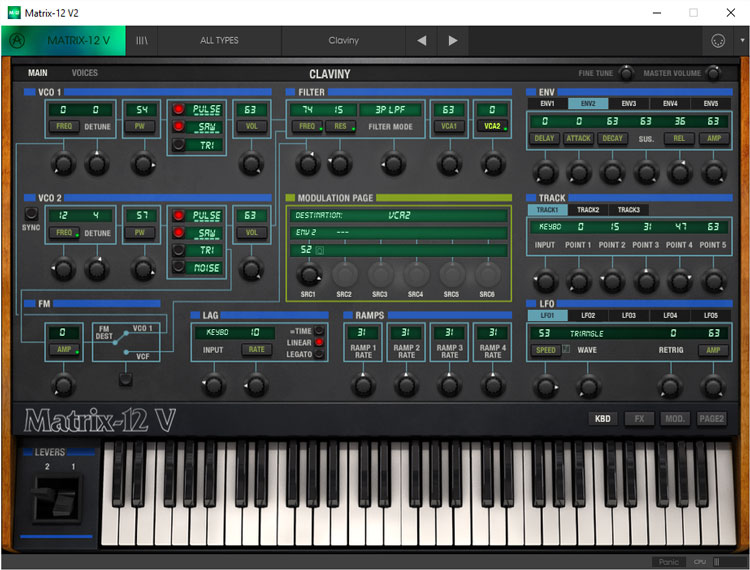
- Modular V.
Another classic Moog synth emulation, this time based on the Moog Modular design.

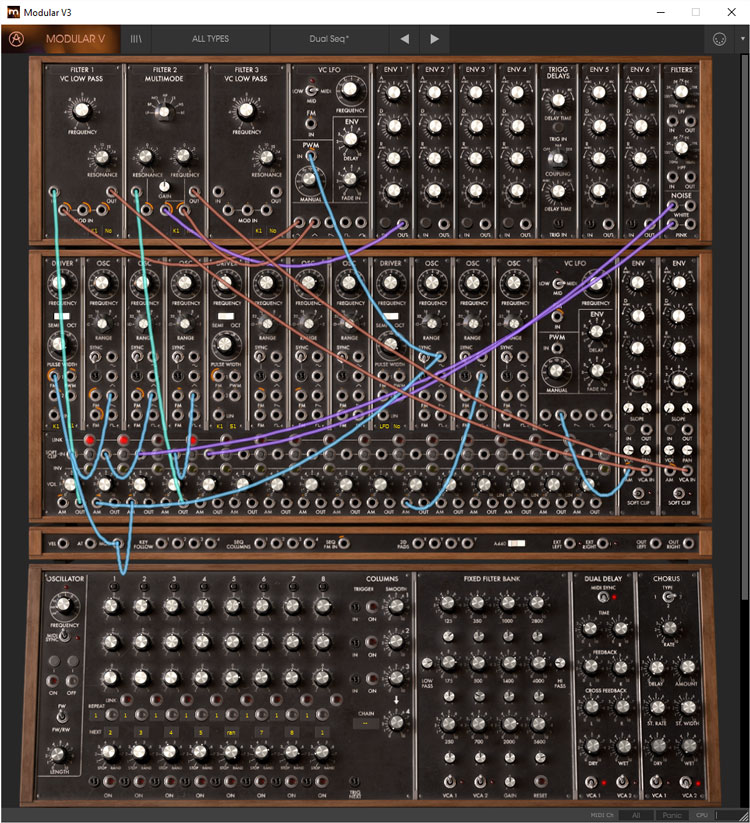
- SEM V.
A software rendition of the Oberheim SEM (Synthesiser Expander Module) from the 1970s.

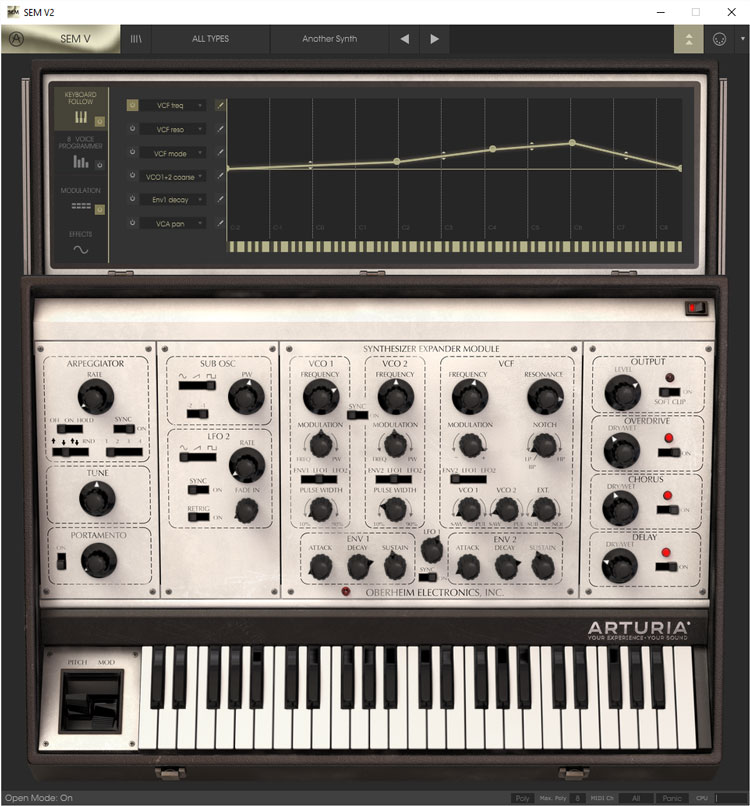
- Prophet V.
An emulation of two Sequential Circuits’ synths – the famous Prophet 5, one of the first polyphonic synths featuring, yes, five voices, and the Prophet VS, one of the first ‘sample + synthesis’ synthesisers.

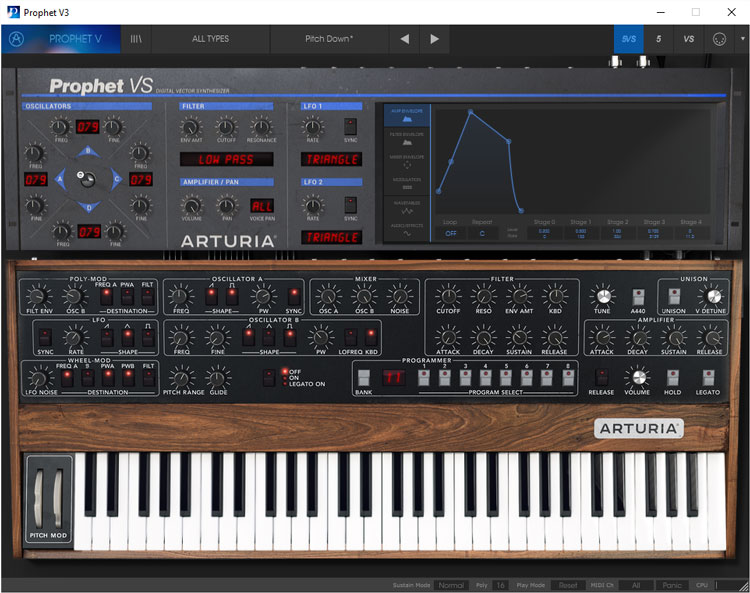
- Solina V.
A software emulation of one of the most sought-after string synthesisers from 1978, the Solina string synth.


- Vox Continental V.
As it says, an emulation of the Vox Continental organ which also used drawbars like the Hammonds.


- Wurli V.
Another name give-away, an emulation of the Wurlitzer EP200 electronic piano.

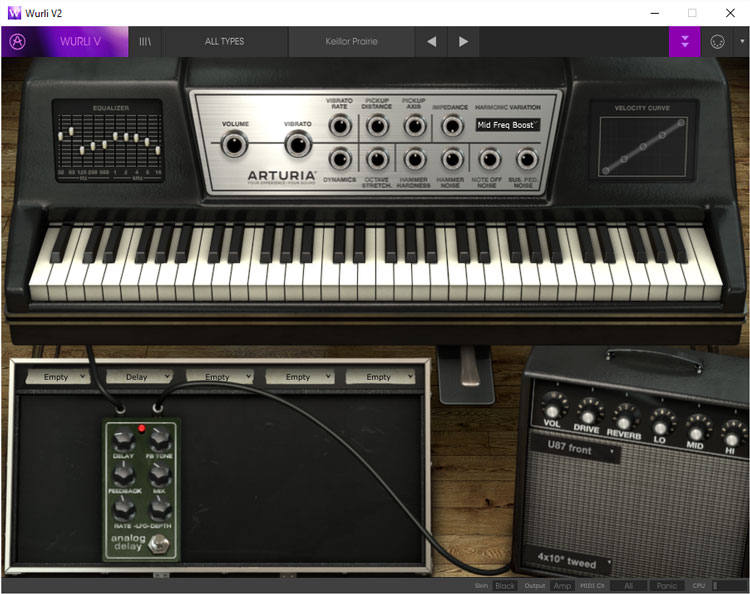
- Analog Lab 2.
A collection of over 5000 presets from the above range of instruments.

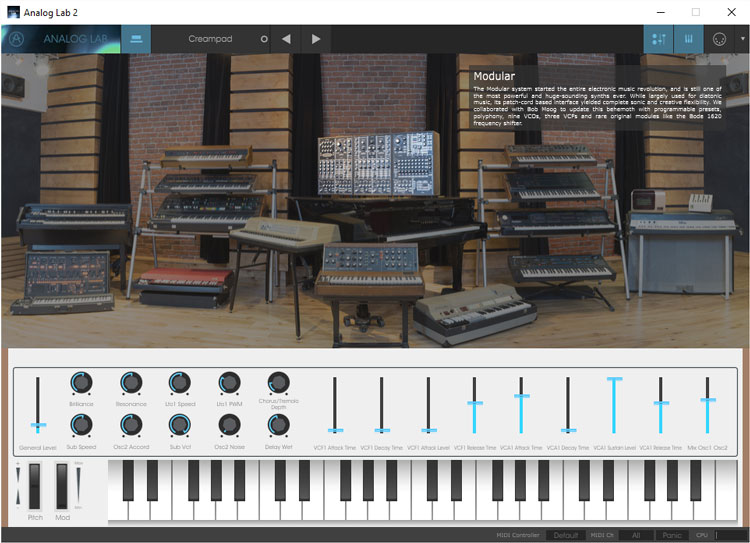
Getting techy
Let’s get the techy bits out of the way first.
These are software emulations, not sampled instruments. Arturia uses what it calls TAE (True Analogue Emulation), custom algorithms, which generate aliasing-free oscillators.
Because the sounds are not samples, the instrument files are very small, saving disk space. You don’t have to wait several seconds when changing sounds or instruments as you’re not waiting for a new sample set to load.
The instruments come in standalone, VST 2, VST 3 and AXX plug-in formats so will integrate with any DAW and, of course, you can use standalone versions for live play – or just for experimenting.
Very graphic
One of the attractions of Arturia’s instruments is the high quality of their graphics and now they have Retina- and 4K-compatible re-sizable graphics. They look brilliant!
And you will need to resize them unless you have a large, high resolution monitor. The full Modular display, for example, even at its lowest size of 60% needs a vertical resolution greater than 1920 to fit it all in. You can scroll through the display, though, of course.
The user interfaces are pretty close to the originals although Arturia has taken the opportunity to add enhancements and make a change here and there to add functionality and aid usability.
One of the benefits of software emulation is the opportunity to improve upon the original and Arturia has done this in several ways.
Can I have more, Sir?
For example, the Wurli has an equaliser section plus several floor pedals and an adjustable combo amp.
The Jup 8 has additional features such as the Galaxy modulation section and a step sequencer.
The Vox Continental has an additional waveform and alternative drawbar options.
The Mini has an arpeggiator, a motion recorder and an effects section.
The Arp 2600 also has several enhanced modules (a multimode filter, for example), an effects section, a ‘tracking’ generator, and includes a soft rendition of the ARP 1601 step sequencer.
The CS-80 has a new modulation matrix for enhanced modulation possibilities.
The B-3 has effects pedals and a step sequencer – on an organ, whatever next!
You get the idea.
In addition, in most cases Arturia has increases the polyphony so monophonic and low-phonic instruments can play polyphonically.
Preset and match
You may disagree, but if there’s one major benefit of software instruments over their hardware counterparts it’s the ability to store presets.
If you ever had an instrument which was unable to store presets you’ll be nodding enthusiastically, although there are still instruments today which can’t store settings: I’m thinking mainly of modular systems.
All the instruments come with a large number of presets which not only save you learning how to program them – ahem – but let you see how the controls work which is especially helpful in the case of the programmable synths.
The instruments have a browser view which shows the presets. They are tagged under Types, Banks and Characteristics so it’s easy to home in on the type of sound you want.
In Kontrol
One of Arturia’s latest developments is to add Native Instruments’ NKS (Native Kontrol Standard) support to their software.
When an instrument is loaded through Native’s Komplete Kontrol keyboard software, for example, NKS enables the hardware controllers on the keyboard to control a range of instrument parameters.
This is great for a bit of hands-on tactility which can make the on-screen synths seem just a little more like hardware. But there is a limit to the number of hardware controls and not every parameter can be adjusted in this way.
NKS can also pop up a browser on screen so presets and, indeed, instruments themselves can be selected from the hardware without having to touch the mouse.
The only instrument without NKS support is Analog Lab. I asked Arturia about this and they said it’s already a host for their other instruments and the sounds would be a duplication.
However, being able to tweak sounds from a hardware controller seems like a missed opportunity, and a possible negative for anyone who decides not to go for the V Collection 5 bundle but would like the 5000 presets in Analog Lab.
For those with other hardware controllers, the instruments support MIDI Learning. Click on the MIDI icon and the parameters that can be controlled change colour. Click on one, twiddle a control on your hardware and the two are then linked.
Is it real?
When considering software instruments you may well wonder how accurate the emulation is.
There will be very few people in the world who could listen to one of these instruments and say if it was the original or not.
There are folks who have some of the originals and who have done A/B comparisons and posted results online (Google is your friend here) but the consensus is, apart from an odd minor anomaly, that they are very accurate indeed. It’s a stunning commendation of Arturia’s programming team.
But total authenticity is only part of the equation. The instruments can be programmed and controlled, and behave like the originals. With enhancements.
I played several of these instruments, back in the day, and did succumb to nostalgia for, well, quite a while, during the review.
However, back then I was never able to afford a Moog or a Prophet and I lusted after an Arp 2600.
A short diversion
Back then, I bought every book on synthesis I could find. As you might imagine, there weren’t many but one I discovered was called ‘Learning Music With Synthesizers’. It was written by ARP founder David Friend and ARP developers Alan R. Pearlman and Thomas D. Piggott in 1974.
It’s an excellent primer and includes sections on sound and music. Of course, examples are based on the ARP and it includes many patch charts.
You’ll be lucky if you can track down a copy now, but those nice people at sonic.net have a PDF along with many other ARP (and other synthesiser) documents, and goodies:
http://sonic.net/mjones/archive/docs/
Books and Modules
I eventually saved up and bought a Roland 100M modular system and got a set of four books published by Roland and collectively called The Synthesizer. The titles were A Foundation For Electronic Music, Practical Synthesis For Electronic Music Volume One, Practical Synthesis For Electronic Music Volume Two, and Multichannel Recording For Electronic Music.
They used the Roland 100M system with patch charts for music examples. Collectively, they’re undoubtedly one of the best learning resources I’ve come across – especially if you have a Roland 100M system 🙂 – or, indeed, any modular synth.
Several years ago I contacted Roland to ask permission to copy the books in order to distribute the wisdom, but after many emails I was told that they didn’t know who the copyright belonged to or it belonged to more than one person and they couldn’t track them down.
However, the books’ authors are totally uncredited and the books are (c) to the Roland Corporation. It’s possible that the authors were employees of Roland so the company would probably retain copyright. Anyway, that idea went down the pan.
But the internet is nothing if not full of resources and it’s amazing what you can find if you look. You might want to start here:
http://www.matrixsynth.com/2012/02/rolands-foundation-for-electronic-music.html
Welcome back
So, after that little sojourn into bookland, let’s get back to business.
Each of the instruments comes with a detailed manual which includes some history behind the original instrument and an explanation of Arturia’s TAE.
The manuals describe every parameter in detail and the synth manuals also delve into the basics of synthesis and how to program the instrument.
Some manuals could do with a little updating but by and large they are exemplary and other music software companies (often with far, far less complicated software) should take note.
You should easily be able to start programming from these instructions although, depending on your knowledge of synthesis, you may want a little more in-depth information – see links above.
The only little niggle is that you have to download each manual individually from the Arturia site, and none contain any mention at all of NKS.
Summary
V Collection 5 will keep you off the streets and in the studio for days, if not weeks. It’s a wonderful opportunity to get all those old synths that you always wanted but could never afford. Well, virtually, at least. Some of these instruments I absolutely love.
I hope that’s not going overboard too much…
You can buy each of the instruments individually – most are €149 although some are €199 – but you’d probably only want to do that if you were interested in just a specific couple of instruments and not in the others.
At the current price of €499 it works out at only €29 each. For sheer VFM it can’t be beat. It’s a veritable musical bargain.


































